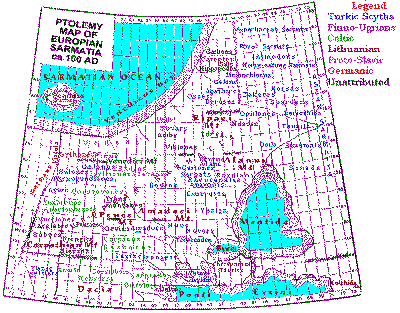Links
http://kraeved.opck.org/kraevedenie/history/sarmati.php (In Russian)
All references are linked to subject articles posted on the site.
Ethno-Political periodization of North Pontic
In the first millennium BC and in the first centuries of our era in the vast expanses of the Great Steppes lived tribes of Sarmatians and Scythians. Scientists believe they were descendants of the Andronov and Timber Grave cultures tribes. The steppes of Southern Urals, where run the boundaries of these cultures, the mutual contacts between them were an active zone of ethnic exchanges that formed the Sarmatian world. The terms “Sarmatians” and earlier “Sauromatians” are collective supra-ethnical notions for a large group of culturally related nomadic tribes. Descriptions of ancient authors give the names of some of these tribes: Aorses, Alans, Roxolans, Siracae, Yazamats, Yaksamats and others. The scholastic dispute on difference between the spellings Sarmat and Sauromat, and the supercerebral periodization concepts based on the archaic differences in spelling are just funny, considering routine variations in spellings for ancient peoples encountered in the sources.
In 2015, great advances were made in genetic research of the Kurgan culture. It was determined that at least a majority of the males in the kurgan burials belonged to the haplogroup R1b. That confirms the archeological observations of the Kurgan waves flooding Europe, the genetical/archeological conclusion that the European males marked by the haplogroups I1, I2, E1b, and R1a had waned and were supplanted by the males marked by the haplogroup R1b, and that for an auspicious period of 4500-3500 ybp (2500-1500 BC) Europe was dominated by the originally Türkic-speaking Kurgan populace, the genetical cousins of the Eurasian Sarmats. The Germanic-Türkic genetic connection explains the heavy presence of Turkisms in Germanic, and particularly in English language, where about 1/3 of the Swadesh-200 basic language comes from the Türkic, a large layer of them come from the very archaic Türkic, and 30-40% of the daily English lexicon, including such basic words as I, do, this, my, make, give, talk, eat, write, tell, kill, earth, time, day, dawn, body, and the little affixes that make English the English ascends to the Türkic phylum.
Etymology of the name Sarmat is disputed, the old Eurocentric ideas receding and reformed with each new “surprising” discovery. Ideas reflect the corners hosting the authors, with the least attention paid to the Uralic peoples and known Sarmatian ethnology. The common traits of the Sarmatian names, the part -mat, and numerous allophones of the part Sar strongly point to a compound Sarymat, with Türkic Sary for “Pale, White, Yellow”, all ethnonyms with an initial component Sary are synonymous with the ethnonyms Kypchak, Kuman; and the enigmatic -mat for “people or group: men, people, tribe, union, race, trait, etc.”, probably a dialectal of men “men” preserved in the name Turkmen ~ “a Turk-like man” and Sarman ~ “Yellow Men”. Examples are too many to list (-mat: Mede, Sarmat, Sauromat, Yazamat, Yaksamat; Sary: Siracae, Saragur, Seres, Saracene, Sarir, Sary As/Saryg, Sary Yogur, Sary Uigur, etc.) In the Zeravshan valley not far from Hissar pass is a whole Sarymat ridge, with Sarytag ~ White Mountain, 4160 m high mountain and valleys of the rivers Kara-kul and Sarymat, where -mat parallels topographical terms -tag ~ mountain and -kul ~ lake, water; in this context -mat apparently serves as a topographical term corresponding to the Türkic mat ~ opaque, matt, darkish, which would make the ethnonym Sarmat < Sarymat = Dark White or Opaque White, matching amazingly precisely the Hippocrates medical observation that Sarmats “are deficient in tone, tawny”. Notably, Sarymat is closer to the initial Greek spelling Sauromat than the later contracted Sarmat. But then, Sarymat would be an exonym, akin to Redskin for Amerindians, no people (naturally, except for the “white” Aryans) would refer to themselves by the color of their skin. The origin of the name is fated to remain speculative.
The most known monuments of thousand-year Sarmatian trace are numerous kurgan burials, reaching 5-7 meters in height.

The indistinguishable Sauromat and Sarmat kurgan burials are often located in groups on high ground, on the top of hills, syrts (Türkic “elevation, height, hill”), offering a broad panorama of the vast steppes. They are hard to miss. Even in ancient times, kurgans attracted attention of grave robbers. The newly organized Russian colonial administration of Orenburg territory in the middle of the 18th c. encountered cooperatives of grave robbers called “marers”, from another Türkic term for kurgans, mar. In 1753 one such group of five people was arrested in the eastern Itil steppes and brought to Orenburg on the order of the Governor I.I. Nepluev. At the beginning of the 20th c. (1911) the peasants of the village Prokhorovka and several neighboring villages of the Orenburg district of St. Michael's Parish (now Sharlyk district) illegally excavated dozens kurgans in search for gold and jewels. Authorities managed to confiscate only a small portion of the artifacts, many of them have vanished. The traditional Türkic attitude toward cemeteries, fed by combination of superstition and indoctrination, required a highest degree of respect to the graves, every passerby was bringing donation as a form of respect and parleying, usually a pebble or small rock, or other little gifts. This tradition is still widespread in the steppes and in the Caucasus, with time the graves by the road accumulate large cairns. The interspersed non-Türkic population and Russian colonist settlers did not necessarily have the same attitude. Ancient cemeteries are considered belonging to nobody, colonial education installs in children views that cemeteries are not theirs, and permission to excavate is granted from the distant capital, irrespectively of local people or local beliefs.
Found in a plowed field on the outskirts of village Kamardinovka of Alexander district.
Orenburg Regional Museum
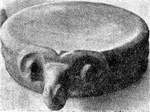
Concerned with the growth of this “archaeological poaching”, scientists and historians became actively involved in studies of ancient kurgan burials in an effort to save priceless monuments of historical antiquities for science. As a result, has been defined a special, so-called Prokhorov Sarmatian culture, was investigated its difference from the Scythian monuments. From the accumulated material scientists uncovered main development stages of the Sarmatian society, produced descriptions of its material culture, and their relations with neighboring tribes and nations.
Important progress was made after excavations of the Filippov kurgans in the Ilek district of the Orenburg province. In one of the tombs dated by the middle of 1st millennium BC was a not looted burial with rich treasure trove, containing more than six hundred highly artistic objects of gold and silver. During the first centuries of planned excavations archeology practically did not exist, the objective was to recover precious objects, the rest was reburied with excavated refuse. Only in the last century attention started to be paid to anthropological and biological studies, traces of rituals, and ethnic differentiations.
The descriptions of ancient authors and rich archaeological material allows to formulate a fairly complete picture of the Sarmatian life. Their economic basis was pastoral nomadism raising sheep, horses, cattle and camels. It was feeding and dressing, gave meat, milk, kumiss, wool, hides and leather, felt, etc.
From early spring to late fall Sarmatians were coaching in the open steppes in wagons covered with felt and drawn by oxen and camels, driving their numerous herds from one pasture to another. Each tribe and clan had their traditional coaching areas, any trespasses led to clashes and tribal wars. In the winter time in different places were arranged housing and shelters to protect people from the elements.
|
The best Classical ethnological description of the Sarmats comes from Hippocrates, ca 400 BC. Not given to hearsay, Hippocrates looks for natural explanation for every observation, and as a physician sees things totally oblivious to generalists. In particular, Hippocrates observations on the constitution of the Sarmats describe exactly what physical anthropologists would discover 25 centuries later. Among Hippocrates observations: 1. Warlike people are free people. Thus, the warlike Sarmats live in democratic society.
That society is akin to Greek democracy, and unlike anything found in traditional
Indo-European societies of any flavor except for Polish Medieval society
with its Sarmat shlyahta The list of Sarmat distinctions compiled by Hippocrates falls far short of what we know today: why they built kurgans (A.Khazanov), their demography (L.Yablonsky), their phenotype (L.Yablonsky), their osteology (D.Pejemsky), their odontology (A.Suvorova), their archeology (too many to list), their genetics and coloration (J.Burger), lactose tolerance aberration, etc. We already know immeasurably more than those neophytes of the 19th and 20th cc. that turned a blind eye to the contemporaries, including Hippocrates, and blessed the world with their self-aggrandizing Scytho-Iranian theory. Internet Classics Archive (
http://classics.mit.edu//Hippocrates/airwatpl.html) Part 16 And with regard to the pusillanimity and cowardice of the inhabitants, the principal reason the Asiatics are more unwarlike and of gentler disposition than the Europeans is, the nature of the seasons, which do not undergo any great changes either to heat or cold, or the like; for there is neither excitement of the understanding nor any strong change of the body whereby the temper might be ruffled and they be roused to inconsiderate emotion and passion, rather than living as they do always in the state. It is changes of all kinds which arouse understanding of mankind, and do not allow them to get into a torpid condition. For these reasons, it appears to me, the Asiatic race is feeble, and further, owing to their laws; for monarchy prevails in the greater part of Asia, and where men are not their own masters nor independent, but are the slaves of others, it is not a matter of consideration with them how they may acquire military discipline, but how they may seem not to be warlike, for the dangers are not equally shared, since they must serve as soldiers, perhaps endure fatigue, and die for their masters, far from their children, their wives, and other friends; and whatever noble and manly actions they may perform lead only to the aggrandizement of their masters, whilst the fruits which they reap are dangers and death; and, in addition to all this, the lands of such persons must be laid waste by the enemy and want of culture. Thus, then, if any one be naturally warlike and courageous, his disposition will be changed by the institutions. As a strong proof of all this, such Greeks or barbarians in Asia as are not under a despotic form of government, but are independent, and enjoy the fruits of their own labors, are of all others the most warlike; for these encounter dangers on their own account, bear the prizes of their own valor, and in like manner endure the punishment of their own cowardice. And you will find the Asiatics differing from one another, for some are better and others more dastardly; of these differences, as I stated before, the changes of the seasons are the cause. Thus it is with Asia. Part 17. In Europe there is a Scythian race, called Sauromatae, which inhabits the confines of the Palus Maeotis, and is different from all other races. Their women mount on horseback, use the bow, and throw the javelin from their horses, and fight with their enemies as long as they are virgins; and they do not lay aside their virginity until they kill three of their enemies, nor have any connection with men until they perform the sacrifices according to law. Whoever takes to herself a husband, gives up riding on horseback unless the necessity of a general expedition obliges her. They have no right breast; for while still of a tender age their mothers heat strongly a copper instrument constructed for this very purpose, and apply it to the right breast, which is burnt up, and its development being arrested, all the strength and fullness are determined to the right shoulder and arm. Part 18. As the other Scythians have a peculiarity of shape, and do not resemble any other, the same observation applies to the Egyptians, only that the latter are oppressed by heat and the former by cold. What is called the Scythian desert is a prairie, rich in meadows, high-lying, and well watered; for the rivers which carry off the water from the plains are large. There live those Scythians which are called Nomades, because they have no houses, but live in wagons. The smallest of these wagons have four wheels, but some have six; they are covered in with felt, and they are constructed in the manner of houses, some having but a single apartment, and some three; they are proof against rain, snow, and winds. The wagons are drawn by yokes of oxen, some of two and others of three, and all without horns, for they have no horns, owing to the cold. In these wagons the women live, but the men are carried about on horses, and the sheep, oxen, and horses accompany them; and they remain on any spot as long as there is provender for their cattle, and when that fails they migrate to some other place. They eat boiled meat, and drink the milk of mares, and also eat hippace, which is cheese prepared from the milk of the mare. Such is their mode of life and their customs. Part 19. In respect of the seasons and figure of body, the Scythian race, like the Egyptian, have a uniformity of resemblance, different from all other nations; they are by no means prolific, and the wild beasts which are indigenous there are small in size and few in number, for the country lies under the Northern Bears, and the Rhiphaean mountains, whence the north wind blows; the sun comes very near to them only when in the summer solstice, and warms them but for a short period, and not strongly; and the winds blowing from the hot regions of the earth do not reach them, or but seldom, and with little force; but the winds from the north always blow, congealed, as they are, by the snow, ice, and much water, for these never leave the mountains, which are thereby rendered uninhabitable. A thick fog covers the plains during the day, and amidst it they live, so that winter may be said to be always present with them; or, if they have summer, it is only for a few days, and the heat is not very strong. Their plains are high-lying and naked, not crowned with mountains, but extending upwards under the Northern Bears. The wild beasts there are not large, but such as can be sheltered underground; for the cold of winter and the barrenness of the country prevent their growth, and because they have no covert nor shelter. The changes of the seasons, too, are not great nor violent, for, in fact, they change gradually; and therefore their figures resemble one another, as they all equally use the same food, and the same clothing summer and winter, respiring a humid and dense atmosphere, and drinking water from snow and ice; neither do they make any laborious exertions, for neither body nor mind is capable of enduring fatigue when the changes of the seasons are not great. For these reasons their shapes are gross and fleshy, with ill-marked joints, of a humid temperament, and deficient in tone: the internal cavities, and especially those of the intestines, are full of humors; for the belly cannot possibly be dry in such a country, with such a constitution and in such a climate; but owing to their fat, and the absence of hairs from their bodies, their shapes resemble one another, the males being all alike, and so also with the women; for the seasons being of a uniform temperature, no corruption or deterioration takes place in the concretion of the semen, unless from some violent cause, or from disease. Part 20. I will give you a strong proof of the humidity (laxity?) of their constitutions. You will find the greater part of the Scythians, and all the Nomades, with marks of the cautery on their shoulders, arms, wrists, breasts, hip-joints, and loins, and that for no other reason but the humidity and flabbiness of their constitution, for they can neither strain with their bows, nor launch the javelin from their shoulder owing to their humidity and atony: but when they are burnt, much of the humidity in their joints is dried up, and they become better braced, better fed, and their joints get into a more suitable condition. They are flabby and squat at first, because, as in Egypt, they are not swathed (?); and then they pay no attention to horsemanship, so that they may be adepts at it; and because of their sedentary mode of life; for the males, when they cannot be carried about on horseback, sit the most of their time in the wagon, and rarely practice walking, because of their frequent migrations and shiftings of situation; and as to the women, it is amazing how flabby and sluggish they are. The Scythian race are tawny from the cold, and not from the intense heat of the sun, for the whiteness of the skin is parched by the cold, and becomes tawny. Part 21. It is impossible that persons of such a constitution could be prolific, for, with the man, the sexual desires are not strong, owing to the laxity of his constitution, the softness and coldness of his belly, from all which causes it is little likely that a man should be given to venery; and besides, from being jaded by exercise on horseback, the men become weak in their desires. On the part of the men these are the causes; but on that of the women, they are embonpoint and humidity; for the womb cannot take in the semen, nor is the menstrual discharge such as it should be, but scanty and at too long intervals; and the mouth of the womb is shut up by fat and does not admit the semen; and, moreover, they themselves are indolent and fat, and their bellies cold and soft. From these causes the Scythian race is not prolific. Their female servants furnish a strong proof of this; for they no sooner have connection with a man than they prove with child, owing to their active course of life and the slenderness of body. Part 22. And, in addition to these, there are many eunuchs among the Scythians, who perform female work, and speak like women. Such persons are called effeminates. The inhabitants of the country attribute the cause of their impotence to a god, and venerate and worship such persons, every one dreading that the like might befall himself; but to me it appears that such affections are just as much divine as all others are, and that no one disease is either more divine or more human than another, but that all are alike divine, for that each has its own nature, and that no one arises without a natural cause. But I will explain how I think that the affection takes its rise. From continued exercise on horseback they are seized with chronic defluxions in their joints owing to their legs always hanging down below their horses; they afterwards become lame and stiff at the hip-joint, such of them, at least, as are severely attacked with it. They treat themselves in this way: when the disease is commencing, they open the vein behind either ear, and when the blood flows, sleep, from feebleness, seizes them, and afterwards they awaken, some in good health and others not. To me it appears that the semen is altered by this treatment, for there are veins behind the ears which, if cut, induce impotence; now, these veins would appear to me to be cut. Such persons afterwards, when they go in to women and cannot have connection with them, at first do not think much about it, but remain quiet; but when, after making the attempt two, three, or more times, they succeed no better, fancying they have committed some offence against the god whom they blame for the affection, they put on female attire, reproach themselves for effeminacy, play the part of women, and perform the same work as women do. This the rich among the Scythians endure, not the basest, but the most noble and powerful, owing to their riding on horseback; for the poor are less affected, as they do not ride on horses. And yet, if this disease had been more divine than the others, it ought not to have befallen the most noble and the richest of the Scythians alone, but all alike, or rather those who have little, as not being able to pay honors to the gods, if, indeed, they delight in being thus rewarded by men, and grant favors in return; for it is likely that the rich sacrifice more to the gods, and dedicate more votive offerings, inasmuch as they have wealth, and worship the gods; whereas the poor, from want, do less in this way, and, moreover, upbraid the gods for not giving them wealth, so that those who have few possessions were more likely to bear the punishments of these offences than the rich. But, as I formerly said, these affections are divine just as much as others, for each springs from a natural cause, and this disease arises among the Scythians from such a cause as I have stated. But it attacks other men in like manner, for whenever men ride much and very frequently on horseback, then many are affected with rheums in the joints, sciatica, and gout, and they are inept at venery. But these complaints befall the Scythians, and they are the most impotent of men for the aforesaid causes, and because they always wear breeches, and spend the most of their time on horseback, so as not to touch their privy parts with the hands, and from the cold and fatigue they forget the sexual desire, and do not make the attempt until after they have lost their virility. Thus it is with the race of the Scythians. Part 23. The other races in Europe differ from one another, both as to stature and shape, owing to the changes of the seasons, which are very great and frequent, and because the heat is strong, the winters severe, and there are frequent rains, and again protracted droughts, and winds, from which many and diversified changes are induced. These changes are likely to have an effect upon generation in the coagulation of the semen, as this process cannot be the same in summer as in winter, nor in rainy as in dry weather; wherefore, I think, that the figures of Europeans differ more than those of Asiatics; and they differ very much from one another as to stature in the same city; for vitiations of the semen occur in its coagulation more frequently during frequent changes of the seasons, than where they are alike and equable. And the same may be said of their dispositions, for the wild, and unsociable, and the passionate occur in such a constitution; for frequent excitement of the mind induces wildness, and extinguishes sociableness and mildness of disposition, and therefore I think the inhabitants of Europe more courageous than those of Asia; for a climate which is always the same induces indolence, but a changeable climate, laborious exertions both of body and mind; and from rest and indolence cowardice is engendered, and from laborious exertions and pains, courage. On this account the inhabitants of Europe are than the Asiatics, and also owing to their institutions, because they are not governed by kings like the latter, for where men are governed by kings there they must be very cowardly, as I have stated before; for their souls are enslaved, and they will not willingly, or readily undergo dangers in order to promote the power of another; but those that are free undertake dangers on their own account, and not for the sake of others; they court hazard and go out to meet it, for they themselves bear off the rewards of victory, and thus their institutions contribute not a little to their courage. Such is the general character of Europe and Asia. Part 24. And there are in Europe other tribes, differing from one another in stature, shape, and courage: the differences are those I formerly mentioned, and will now explain more clearly. Such as inhabit a country which is mountainous, rugged, elevated, and well watered, and where the changes of the seasons are very great, are likely to have great variety of shapes among them, and to be naturally of an enterprising and warlike disposition; and such persons are apt to have no little of the savage and ferocious in their nature; but such as dwell in places which are low-lying, abounding in meadows and ill ventilated, and who have a larger proportion of hot than of cold winds, and who make use of warm waters - these are not likely to be of large stature nor well proportioned, but are of a broad make, fleshy, and have black hair; and they are rather of a dark than of a light complexion, and are less likely to be phlegmatic than bilious; courage and laborious enterprise are not naturally in them, but may be engendered in them by means of their institutions. And if there be rivers in the country which carry off the stagnant and rain water from it, these may be wholesome and clear; but if there be no rivers, but the inhabitants drink the waters of fountains, and such as are stagnant and marshy, they must necessarily have prominent bellies and enlarged spleens. But such as inhabit a high country, and one that is level, windy, and well-watered, will be large of stature, and like to one another; but their minds will be rather unmanly and gentle. Those who live on thin, ill-watered, and bare soils, and not well attempered in the changes of the seasons, in such a country they are likely to be in their persons rather hard and well braced, rather of a blond than a dark complexion, and in disposition and passions haughty and self-willed. For, where the changes of the seasons are most frequent, and where they differ most from one another, there you will find their forms, dispositions, and nature the most varied. These are the strongest of the natural causes of difference, and next the country in which one lives, and the waters; for, in general, you will find the forms and dispositions of mankind to correspond with the nature of the country; for where the land is fertile, soft, and well-watered, and supplied with waters from very elevated situations, so as to be hot in summer and cold in winter, and where the seasons are fine, there the men are fleshy, have ill-formed joints, and are of a humid temperament; they are not disposed to endure labor, and, for the most part, are base in spirit; indolence and sluggishness are visible in them, and to the arts they are dull, and not clever nor acute. When the country is bare, not fenced, and rugged, blasted by the winter and scorched by the sun, there you may see the hardy, hardy, slender, with well-shaped joints, well-braced, and shaggy; sharp, industry and vigilance accompany such a constitution; in morals and passions they are haughty and opinionative, inclining rather to the fierce than to the mild; and you will find them acute and ingenious as regards the arts, and excelling in military affairs; and likewise all the other productions of the earth corresponding to the earth itself. Thus it is with regard to the most opposite natures and shapes; drawing conclusions from them, you may judge of the rest without any risk of error. And there are in Europe other tribes, differing from one another in stature, shape, and courage: the differences are those I formerly mentioned, and will now explain more clearly. Such as inhabit a country which is mountainous, rugged, elevated, and well watered, and where the changes of the seasons are very great, are likely to have great variety of shapes among them, and to be naturally of an enterprising and warlike disposition; and such persons are apt to have no little of the savage and ferocious in their nature; but such as dwell in places which are low-lying, abounding in meadows and ill ventilated, and who have a larger proportion of hot than of cold winds, and who make use of warm waters- these are not likely to be of large stature nor well proportioned, but are of a broad make, fleshy, and have black hair; and they are rather of a dark than of a light complexion, and are less likely to be phlegmatic than bilious; courage and laborious enterprise are not naturally in them, but may be engendered in them by means of their institutions. And if there be rivers in the country which carry off the stagnant and rain water from it, these may be wholesome and clear; but if there be no rivers, but the inhabitants drink the waters of fountains, and such as are stagnant and marshy, they must necessarily have prominent bellies and enlarged spleens. But such as inhabit a high country, and one that is level, windy, and well-watered, will be large of stature, and like to one another; but their minds will be rather unmanly and gentle. Those who live on thin, ill-watered, and bare soils, and not well attempered in the changes of the seasons, in such a country they are likely to be in their persons rather hard and well braced, rather of a blond than a dark complexion, and in disposition and passions haughty and self-willed. For, where the changes of the seasons are most frequent, and where they differ most from one another, there you will find their forms, dispositions, and nature the most varied. These are the strongest of the natural causes of difference, and next the country in which one lives, and the waters; for, in general, you will find the forms and dispositions of mankind to correspond with the nature of the country; for where the land is fertile, soft, and well-watered, and supplied with waters from very elevated situations, so as to be hot in summer and cold in winter, and where the seasons are fine, there the men are fleshy, have ill-formed joints, and are of a humid temperament; they are not disposed to endure labor, and, for the most part, are base in spirit; indolence and sluggishness are visible in them, and to the arts they are dull, and not clever nor acute. When the country is bare, not fenced, and rugged, blasted by the winter and scorched by the sun, there you may see the hardy, hardy, slender, with well-shaped joints, well-braced, and shaggy; sharp, industry and vigilance accompany such a constitution; in morals and passions they are haughty and opinionative, inclining rather to the fierce than to the mild; and you will find them acute and ingenious as regards the arts, and excelling in military affairs; and likewise all the other productions of the earth corresponding to the earth itself. Thus it is with regard to the most opposite natures and shapes; drawing conclusions from them, you may judge of the rest without any risk of error. The end |
Finds of many copper, bronze, and iron objects indicate that the Sarmatians knew mining and metalwork. Searching for ores, they often followed the paths trodden by their Andronov and Timber Grave ancestors, mining in the same places. The weaponry blacksmiths forged iron swords and daggers; the master founders cast bronze and copper caldrons, mirrors, metal parts of horse harnesses, ornaments; the jewelers produced objects of precious metals..
and iron dagger (hamlet Nemyatovka in Pervolot district. Chance find, 1962).
Orenburg Regional Museum

Sarmatian social order consisted of clan communities, which included groups of kindred families. Burials and kurgans usually are compact groups of the burials of one clan.
A particular feature of the Sarmatian social system, especially in the early Sauromat period (6th-4th cc. BC), women had a high status in the family and society, a kind of gynecocracy, i.e. female domination. They were not only guardians of hearth and caregivers of children, but also the soldiers equal with men. Some daydreaming archeologists also ascribe to noble women honorable priestly functions, nonexistent in the priestless Tengrian religion. That trend started when religion dominated science, and religious scientists were interested in us vs. them contradistinction. Notably, in the deceased woman grave, even for the girls, were often placed weapons in addition to jewelry. The ancestral cemetery as a rule formed around an earlier burial of a noble woman - a venerated pra-mother of the clan relatives. That traditional Türkic respect for women survived for more than a millennia even in the Islamic and Christianized societies; it is one of the traits that distinguishes the Türkic societies from the Indo-European and Indo-Iranian innate traditions. Nowhere is the difference stronger than in the North-South division of Europe, documented from the Classical times. Greeks, Romans, and Arabs were shocked to witness respect and freedom afforded to the women in Etruscan, Scythian, and Türkic societies, they spent innumerable efforts to change their culture to subjugate females, mostly with little success. The Southern Europe still remains a male-dominated society, while the Germanic Northern Europe with unmistakable Türkic connections retains much of the female freedom, and unlike the Southern Europe, commonly has females leading the states and females governing the states. Notably, nearly all known female heads of state from antiquity to the Middle Ages and the rise of religious Judeo-Christian-Islamic domination ruled the Türkic states. For Germanic - Türkic connections see G. Ekholm German Ethnology, R. Mc Callister Non-IE substrate vocabulary in Germanic languages, A. Toth Turkic and English, C. Stevens Germanic-Türkic traits.
Procopius of Caesarea in that respect made a remarkable comment, for our times and our
imaginative historiography:
... I shall tell who they (the Goths) were and
in what manner they did so. There were many Gothic nations in earlier times, just as also at the
present, but the greatest and most important of all are the Goths, Vandals, Visigoths, and Gepaedes.
In ancient times, however, they were named Sauromatae and Melanchlaeni
(“Black-cloaks”); and there were some too who called these nations Getic. All these,
while they are distinguished from one another by their names, as has been said, do not differ in
anything else at all. For they all have white bodies and fair hair, and are tall and handsome to
look upon, and they use the same laws and practice a common religion. For they are all of the Arian
faith (i.e. monotheistic Tengrianism, in contrast with Trinity),
and have one language called Gothic; and, as it seems to me, they all came originally from one
tribe, and were distinguished later by the names of those who led each group. This people used to
dwell above the Ister (Danube) River from of old. Later
on the Gepaedes got possession of the country about Singidunum
(Belgrade) and Sirmium (Mitrovitz), on both
sides of the Ister River, where they have remained settled even down to my time.
About the Sarmatian female warriors were telling the ancient authors who lived during that era.
Thus, the Greek historian Herodotus noted that their women “go hunting on horseback with their husbands and without them, go to war and wear the same clothes as men... No girl gets married, until she kills an enemy”. Hippocrates also reported that the Sarmatian women ride on horseback, shoot from bows and throw spears. He cites such an amazing wonder: girls had often their right breast removed, so that all strength and vitality went into her right shoulder and arm, and made a woman strong on a par with man. Sarmatian female warriors probably served as a model for ancient Greek legend about the mysterious Amazons. It is well known that no Classical historian ever compared any Indian or Iranian-stock woman with Amazons, or their men with Scythians; the only direct identification of Amazons with contemporary people by the Classical authors was with the Bulgarians or the tribes of the Bulgarian circle, who also were routinely labeled Scythians.
Some classical historian accused Sarmatians that their main occupation, like of many other “Scythian” and Hunnic tribes was a war. Numerous detachments of Sarmatian cavalrymen, often protected by cataphract armor and chain mail, armed with long iron swords, bows and arrows, were terrifying neighboring peoples and states. The Romans, faced with Sarmatian threat, described these nomads: “Fierce face, rough voice, neither hair no beard are trimmed, no one of them goes without wearing a quiver, bow, and arrows bluish from venom”. Notably, the Indo-European languages do not have their own word for the quiver, the cognates of the word quiver are present in only a handful of modern Indo-European languages, while the Türkic languages have a spectrum of synonyms, including for an arrow pouch in the tall boots; quivers are frequently depicted on the kurgan grave stones spanning millenniums and across Eurasian continent depicting nomadic deceased; the Türkic origin of the word quiver is a recognized fact: “quiver is “case for holding arrows,” early 14c., from Anglo-Fr. quiveir, O.Fr. quivre, probably from P.Gmc. *kukur “container” (cf. OHG kohhari, OFris. koker, OE cocur “quiver”); said to be from the language of the Huns”. Ditto for Greek hapax gorit, likely borrowed from the Scyths; for foot hunter and soldier quiver is a weight to drag, while for mounted hunter and soldier quiver is a convenience and necessity. The industry of poison largely escaped attention of the researchers, although it sheds light on the contrasts between nomadic and sedentary cultures: in sedentary societies rulers had to either organize centralized production of weaponry, or wield peasant armies armed with pitchforks; in nomadic societies army was a self-equipped militia, where each family furnished a battle-ready soldier, and thus each family had to know the spectrum of natural poisons, technique of their production, and ability to produce effective concoction to protect their own husband and father.
Found in 1911 in Prokhorovka kurgan of Sharlyk district.
Orenburg Regional Museum
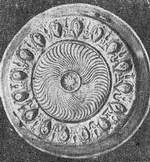
Sarmatians not only fought and had hostile relations with other people, but also had fairly extensive trade with the outside world. The geography of these links is evidenced by the the beautiful Middle Asian golden jewelry, imported vessels and seals, Phoenician glass, alabaster vessel with Egyptian inscription, boxwood comb, iron armor of the Greek manufacture, etc., found in the Sarmatian graves in the Orenburg steppes, in Pyatimar (Russified “Five Kurgans”), Mechet-Sai (Mosque-Sai), Prokhorovka, Pokrovka, Tara-Butak, Nejink, Orsk, Fillipovka, etc.
Among the crafts and jewelry made by Sarmatian and foreign masters predominate objects executed in so-called “animal style”, also inherent to the Scythians, Sakas, Massagets-Masguts, Huns, and other related Türkic peoples. The weapons, household objects, jewelry, horse harness depicted wild animals: bars (leopard), panther, wolf, bear, deer, mountain goat, wild boar, eagle, and also sheep, horse, etc. The images are stylized and full of dynamics and expression. A common motif was struggle of wild beasts.
The aery explanation of amateur archeological theologians was that “Animal Style” was born out of religious beliefs associated with worship of animals. The same theologists suggested that the leading place in the religious beliefs of Sarmatians was held by a “cult of fire” associated with the worship of sun as a chief deity. They were led to this conclusions by observations of the remains of the funerary feast, a ritual described numerously and in detail for Türkic kurgan burials. Over the grave of a deceased kin were set up cookfires, and in case of cremation also was set up a funeral pyre, the remains of the funeral pyre were buried in the burial pit, and the remains of the funerary feast, i.e., leftover food, coals, burnt and calcined soil, dishes and utensils covered kurgan and its surrounds, adding a new layer after every wake memorial. The little tables accompanying the deceased into the other word were fancifully interpreted as altars, and tables found in female burials were advertized as appurtenances of priestesses. Sarmatians were also accused of abandoning their Sun-god and switching to a replacement worship of the sword, symbolizing the god of war. The intent of these Russian-authorized city legends was to distract from the continued modern practice of funerary feasts among the Türkic peoples living under various dominating religions, and to create an fictitious link to Zoroastrianism, re-interpreting Türkic rituals as amorphous Indo-European. These conjectures are handedly, and mostly unwittingly, debunked by ethnological researchers.
With the growth of population, increase in the size of the herds, the Sarmatian pastures were expanded. Over time, they occupied a vast territory from the river Tobol (68°E) to the river Dnieper (30°E) River and North Caucasus (45°N). Pressed from the east by the Huns and other tribes, the Sarmats called Alans (i.e. generic “Steppe People”) at the end of the 4th c. migrated to the west, reached the Roman Empire, Pyrenees, and even North Africa. They gradually melted in the mass of other nations. According to the Russian canonical doctrine that peaked in 1930-1970s, Sarmats disappeared from their motherland, and are nowhere to be found. However, the falsity of that doctrine was fairly clear even to its advocates, and like the idea of the Iranian linguality of the Sarmats it was held together only by the watchful eye of the state stagging and neglect of the research field.
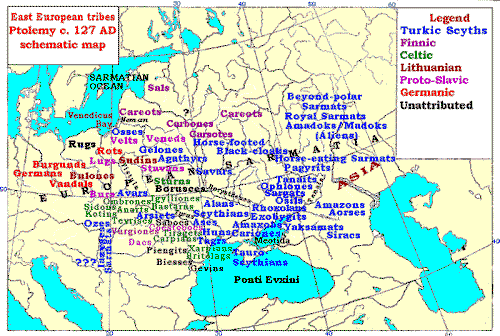
The one and only, published only preliminary genetical study of the Pokrovka-15 population found their genes spread far and wide in the modern populations (See Joachim Burger Mamas of Pokrovka Sarmatians). The westward tracks correlate well with the historical records, tracing the paths around Northern Mediterranean to Africa, and western-northward trek into Scandinavia and eventually to Iceland (see Faux D. Kurgan Culture in Scandinavia). The southeastern trek is also known, down to Nepal and SW China. The remaining Central Eurasian locations from Itil to Baikal may reflect the motherland and the spread of Andronov and Timber Grave cultures tribes. So far, archeological and anthropological conclusions are that Sarmats are autochthonous descendents of the cultures that started with Khvalynsk and Sredni Stog, which originated Andronov and Timber Grave cultures.
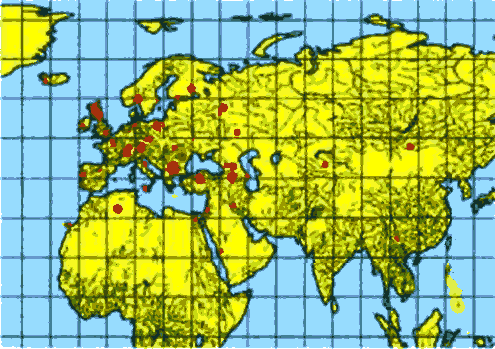
Apparently, at around 150 AD started events that forced archeologists to divide Sarmatians into Early Sarmats and Late Sarmats. Culturally, the Early Sarmats and Late Sarmats represent a single branch of the Eurasian horse nomads that include all Türkic kurgan people and some other culturally and linguistically acculturated peoples. Their common funeral tradition testifies to their universal priestess monotheistic Tengriism religion, probably syncretized with various local influences.
But anthropologically, between Early Sarmats and Late Sarmats lays a sea of difference. While the Early Sarmats are expressed local Uraloids, the Late Sarmats include males connected with Kazakhstan's Jetyasar culture, which is tentatively attributed to the Kangar tribes (of the Bajanaks-Bosnyaks, Kangar Union, and Eastern Hunnic Kangar allies). The change is historically connected with the establishment of the Hunnic state centered around Aral Sea after Huns moved the center of their state from the Balkhash area, before that from the Dzungaria area, before that from the Otuken area, and before that from the Ordos area. On their moves, the Huns involved masses of their subject affiliates, altogether called Huns. For all practical purposes, the Late Sarmats are known in history as Western Huns or European Huns. Before they started a reverse trek, the future Huns were moving from Eastern Europe in the eastward direction, arriving as Andronovans in the vicinity of Ordos, and bringing to the Far East knowledge of horses, metals and metalwork, and “turtle shell' pictograms that developed into Chinese hieroglyphs. The horsed Andronovans were recorded as Juns (pyn. Rong), which is quite allophonic with Huns.
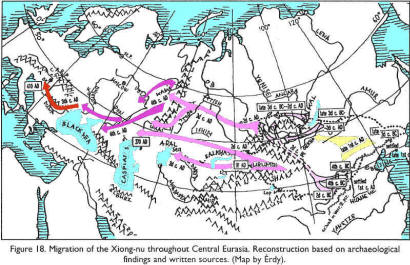
The anthropological description of the Early Sarmats, which are classical Sarmats or Sarmats per se, known from the Classical literature, depicts expressed local Uraloids, classed as Caucasoids with some Mongoloid admixture (Ref. Yablonsky L.T. et al. Paleoanthropology of Southern Urals population in Late Sarmat time). References to facial flatness allude to Mongoloidness. Genetically, Uraloids are proto-Mongoloid admixture that reached European Caucasoids tens of millenniums ago. In contrast, the Indo-Aryan or Irano-Aryan (aka Iranic, Iranoid, Dinaric) race is defined as dolichocephalic, leptorrhine ( (long-headed, with long narrow nose), tall, robust large-boned (though distinguished by slender gentle bones), dark-haired, and fair-skinned with straight hair. It should be noted that the Uraloid Early Sarmats westward as a predominantly male conglomerates, fleeing from the Jetyasar invaders and leaving their women behind. In new places, they procreated with the local women, quickly changing their phenotype with every generation, but retaining their hallmark cranial deformation custom. The custom of cranial deformation was nearly universal at the Sarmatians, the cranial deformation is emphatically denied by Iranian scholars as present among the Iranian peoples. Contrast is clear from the following description of the Sarmats.
Craniology.
Male and female artificially deformed skulls
characterized by the following features:
Almost all skulls have more or less distinct
traces of intravital artificial cranial deformation, circular or orbital type, and
sometimes in addition occipital-parietal type, with singular exceptions.
They are meso-brachicranial with low crania,
relatively gracile, hypomorphic, low-faced.
These skulls have underdeveloped glabellar and brow relief.
Their orbits are of medium height, nose bridge area is somewhat flattened at nasion
level, and also in cross-section at symotic points, which as a rule leads to large values
of the nasomalar angle (with median values of the zigomaxillar angle).
Some skulls of
this group, along with general flattening of the facial skeleton in the horizontal
plane, have a slight alveolar prognathism.
The nose protrusion angle is most
often moderate.
| Types of cranial deformation | |||||||||
|---|---|---|---|---|---|---|---|---|---|
| Fig. 2. Occipital-parietal cranial modification | Fig. 3. Tabular cranial modification | Fig. 4. Circular cranial modification | |||||||
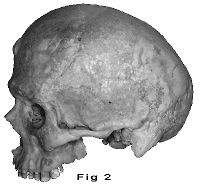 |
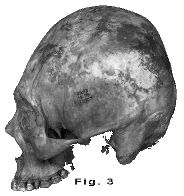 |
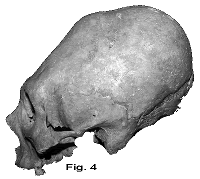 |
|||||||
| Photogallery | |||||||||
 |
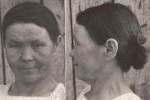 |
 |
 |
 |
 |
 |
 |
 |
 |
| Phenotype - Uraloid Morphological and descriptive traits |
|||||||||
|
1. Cephalic index: mesocephalic. 2. Face Index: mesoprosopia, euriprosopia. 3. Height of head: low, medium. 4. Occipital: protruding. 5. Horizontal profile of face: weakened profiling of face, lowered nasal root. 6. Angle between nose protrusion and axis of profile: reduced. 7. Nasal bridge profile, nose tip position, position of the axes: weakly concave, concave nose crest, raised nose tip, large angle between nostrils. 8. Width of nose: broad nose. 9. Slope of optic fissure: moderately expressed Mongoloid slope. 10. Perioral area: procheilia, thin or medium-sized mucous of the lips. 11. Vertical profile of the face: mesognathia, prognathism. 12. Forehead slope: moderate. 13. Brow ridges: weakly expressed. |
14. Jaw: medium breadth, angular, short in height. 15. Chin: straight or slightly receding. 16. Beard and mustache, tertiary hair: below-average beard development (Cheboksarov 3rd degree), and decreased chest hair. 17. Eye color: black, dark brown, brown, light brown, yellow, yellow and green (No 1-6 on Bunak scale). Green = light brown + bluish-grey. 18. Epicanthus: medium, strong, swelled upper eyelid. 19. Hair color: from black to blond. 20. Skin phototype: Fitzpatrick type No 3, tannable. 21. Structure form of hair: straight. 22. Height: small, medium. 23. Body type: male by Bunak thoracic, thoracic-muscular. Women by Galante asthenic, plastic-stenotic, i.e. slender |
||||||||
Odontological:
(Funny thing, you can earn your keep
by lying about etymology or linguistics, but we have yet to see somebody lying about Carabelli cusp.
Is that a real reason behind the dearth of stomatologists in this world?)
The morphology of the dental system allows to regard the Early Sarmats as belonging to
the western odontological stem:
They are characterized by complete absence of spatulate upper medial incisors, but with
the presence of spatulate lateral incisors, low reduction levels of the second upper
molar metacone and moderate frequency of Carabelli cusp, and low frequency six-cusp first
lower molars.
Early Sarmats have
significant gracilization of the mandibular molars: a large frequency of four-cusp first
molars, incidence of three-cusp second molars.
A reflection of the general gracilization of the tooth-jaw apparatus is manifested in the
reduction of alveolar process, which entails, among other things, increase in the
frequency of fused roots. In that respect, notable is
the low frequency of differentiated premolar and molar roots (three-root molars
were not observed).
A typical feature of the Early Sarmats is extremely high hypodontia of the wisdom tooth molars (M3),
which finds no parallels among the synchronous populations of the Early Iron Age:
The absence of
at least one third molar was recorded in 61.9% of the Early Sarmats.
More or less similar rates
were observed only in the Eastern Aral Sea area among the people of the Jetyasar Culture buried in the crypts,
tentatively attributed to the Kangars - Kangly tribe, 200 BC - 800 AD.
The Jetyasar people are the only group where hypodontia was recorded in 55.6% of the
cases.
The comparative data demonstrates how high the was hypodontia of the Early Sarmats: the
frequency of congenital absence of the M3 rarely exceeds 20% in the ancient populations and
30% today.
The presence of the southern vector connection of the Early Sarmatians is indicated by a very high frequency of such traits as the distal crest and epicristid. The latter usually occurs in populations in 1-2% of cases, but in the Early Sarmatian sample it is present in 7.7% of the cases. The high frequency of epicristid can simultaneously serve as a pointer to some archaic odontological complex, which is supported by very high incident frequency of oblique ridge on the first upper molar.
In the Early Sarmatians, the frequency of the inter-root pocket of enamel on the second molars are rather high compared with European populations, in Late Sarmatian time it increases, reaching values typical for the members of the Eastern/Asian odontological stem.
Osteological (Late Sarmats):
The Southern Urals Late Sarmatians at the population level can be characterized as
medium massive, with body length of males 168-169 cm and females 154-155 cm. Both parts of
the sample have inherent constitutional peculiarities, expressed in shortened lower
extremities relative to the arms length (primarily due to the short shank), a result of
the Late Sarmatians' Mongoloid admixture.
The upper diaphyses cross-section forms of the long bones in the studied group are
in good agreement with the Sarmatian population's nomadic type of economy, and testify to a
significant role of mounted riding in their life activities.
The peculiarities of elements in the long bones macrorelief of the Late Sarmatian also shows
the “equestrian complex” that allows to refine morphological status of the female
population, for whom the horse-riding probably played a much lower role.
Anthropological examination of the Sarmats excludes any chance that Sarmats have anything to do with Indo-Iranians, Iranians, Ossetes, or any combination thereof. Anthropological examination is consistent with the known historical records about Sarmats and archeological discoveries, and totally inconsistent with the Scytho-Iranian theory that is hanging on the chain Iranian-Ossetian-As-Alan-Sarmatian-Scythian that led to the victorious equating Iranian = Scythian, and associated pertaining propaganda.
With all the vastness of the Sarmatian lands, the most assimilated and populated Sarmatian area was South Urals, Caspian-Aral basin, and the Northern Kazakhstan steppes. Suffice it to say that only on the banks of the river Ilek in its middle and lower course were identified more than 150 kurgan cemeteries, of which 60 belong to the early, “Sauromat” time (6th-4th cc. BC), and 80 to the period of the so-called Early Sarmatian Prokhorov culture (4th-2nd cc. BC). The excavated Late Sarmat kurgans number in hundreds. But not only the silent kurgans are the witnesses of the millenniums-long Sarmatian history. The place names also bear testimony about them: names of the rivers, lakes, mountains, and locations. For example, it is known that the names of the rivers in the Orenburg region, the Sakmara, Samara, Kasmarka, etc., bear names of the Sarmatian Türkic-speaking origin. The original culture of the Sarmatians undoubtedly has influenced the development of the cultures of other tribes and nations.
Background:
L.I. Futoryansky. “History of the Orenburg region”, Chelyabinsk, South Ural book Press, 1968.
pp.
59-69.
